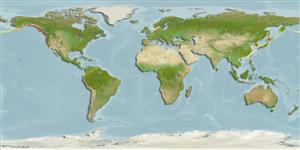Common names from other countries
Environment: milieu / climate zone / depth range / distribution range
Ecologia
; intervalo de profundidade 0 - 28 m (Ref. 865). Temperate
Pacific Ocean. Subtropical to boreal.
Length at first maturity / Tamanho / Peso / Idade
Maturity: Lm ? range ? - ? cm Max length : 18.0 cm TL macho/indeterminado; (Ref. 822); common length : 4.0 cm TL macho/indeterminado; (Ref. 822)
Assumed maximum and common length from Ref. 822. Feeds on crustaceans, prosobranchs, tunicates, sponges and bryozoans. Predator: polycerid nudibranch and the sea tiger (Ref. 844).
Life cycle and mating behavior
Maturidade | Reprodução | Desova | Ovos | Fecundidade | Larvas
Members of the order Nudibranchia are simultaneous hermaphrodites. Mating behavior: Both individuals darts their penis toward each other to induce one to act as a male and the other as the female. The victorious one to penetrate the body wall is the dominant male. Life cycle: Eggs are deposited on a substratum where they develop and hatch into (planktonic) vestigial veliger larval stage and further grow as adults.
Debelius, H. 2001. (Ref. 844)
Categoria na Lista Vermelha da IUCN (Ref. 130435)
Categoria CITES (Ref. 108899)
Not Evaluated
Not Evaluated
Utilização humana
| FishSource |
Ferramentas
Mais informação
Idade/Tamanho
Crescimento
Comprimento-peso
Comprimento-comprimento
Morfologia
Larvas
Abundância
Fontes da internet
Estimates based on models
Preferred temperature
(Ref.
115969): 7.6 - 17.9, mean 10.7 (based on 569 cells).
Vulnerabilidade
Low vulnerability (10 of 100).
Categoria de preço
Unknown.
